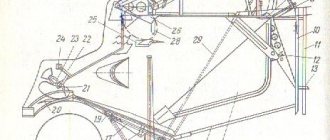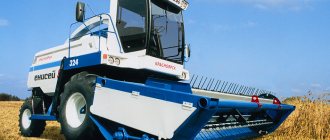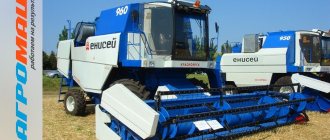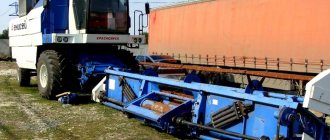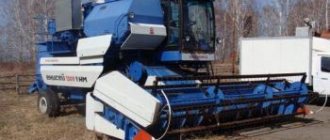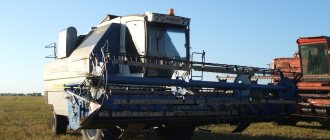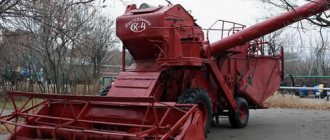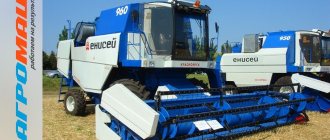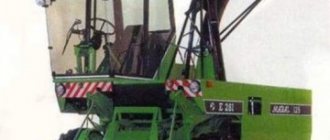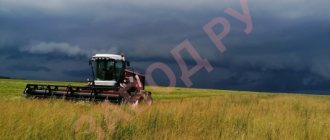The Yenisei combine is a list of models of agricultural machinery produced at the combine plant in Krasnoyarsk. The Yenisei 1200 model is a technique for harvesting grain crops. Production began after the sixties of the 20th century. The Yenisei line is a drum cleaning equipment with an adjustable number of drums. Additional drums are supplied upon agreement with the seller. The harvesting machine with the highest productivity is a combine with two drums, fans and straw walkers installed. With this configuration, productivity is the highest, while the efficiency of work in a small field decreases. It is advisable to use the Yenisei line on a planted field with a large running area.
Combine harvester Yenisei 1200
The history of the creation of the Yenisei-1200 combine harvester
"Yenisei-1200" and its plant today
This is not surprising: the Yenisei-1200 has extremely unpretentious and surprisingly reliable diesel engines that operate quietly even on low-quality fuel; and the entire design of the combine is characterized by simplicity, durability and a high degree of maintainability. At the same time, spare parts are cheap, and repairs can be made directly in the field, without resorting to the services of service specialists. Therefore, these combine harvesters, both those that were produced in the 2000s, and even those made in the 80s, still have a long and “full of accomplishments” working life ahead of them.
Modifications of the Yenisei-1200, as well as its more compact “brother” - with the letter “950” and the trademark “Ruslan”, continue to be produced in limited quantities in our years. But not in Krasnoyarsk, but at the facilities of the Cheboksary Promtractor.
The Krasnoyarsk Combine Harvester Plant suffered the fate of many glorious enterprises of the Soviet era, which, by the will of fate, ended up on sites attractive for the construction and sale of large residential complexes. In 2013, the plant was closed, and its area of 20 hectares was sold for the implementation of a large real estate development project.
Descendant of “Kommunard”, “Stalinist” and “Sibiryak”
It is impossible not to recall that it was the Krasnoyarsk Combine Harvester Plant, being a leading enterprise in the industry, that was the first in the Soviet Union to begin producing a self-propelled combine with a separate cabin for the driver: it was the famous SKD-5 “Sibiryak”, produced from 1969 to 1981.
In general, the history of this glorious enterprise started in the harsh October of 1941, when the production facilities and technical equipment of the Kommunar agricultural machinery plant were evacuated from the city of Zaporozhye to Krasnoyarsk. This became the basis of the future KZK, coupled with the machines of the Alexey Ukhtomsky Agricultural Machinery Plant, which was brought here from the city of Lyubertsy.
During the Great Patriotic War, the Krasnoyarsk Combine Harvester Plant produced mortars, ammunition for them, as well as artillery shells of various calibers. However, already on April 13, 1944, the first combine harvester, called the “Krasnoyarsk Communard,” left the factory gates, and by Victory Day on May 9, 1945, 350 of these trailed agricultural machines had already been produced.
The beginning of the plant’s own dynasty of “Siberian heroes” was laid in 1947, with the production of the first self-propelled harvester in the Union, S-4 “Stalinets”. This was a significant step forward: this agricultural machine did not need a tractor and was serviced by one person, not five.
Modifications of the “Stalin” - SK-3 (1959) and SK-4 (1965) became transitional models on the way to the first “bestseller” of the industry - the Sibiryak combine, which absorbed all the production achievements of that time and bold design solutions. Including, and this was again a first in the Soviet Union, a double-drum threshing system, which made it possible to increase the throughput of the combine by 48 percent.
Combine harvester SKD-5 Sibiryak
A tracked double-drum modification of the “Sibiryak” was invented and successfully implemented for working in conditions of high humidity on rice plantations. These innovative solutions were developed at Yenisei.
A solid team of scientists from the Novosibirsk State Agricultural Institute (now the Agrarian University, NSAU) worked for many years on the creation of the Yenisei-1200, together with the design bureau of the Krasnoyarsk plant. Prototypes of the new model were tested not in the quiet of offices, but on the fields of the Tulinskoye and Elite experimental production farms.
Of course, the Yenisei-1200 was created with an eye not only on the products of Rostov colleagues (Niva combines), but also on the best foreign examples of agricultural machinery of that time. The result of painstaking work was the creation of a fundamentally new third-class grain harvester, the use of which can significantly reduce grain losses and effectively thresh even in conditions of high humidity or when grains are lying down - less dependent on the vagaries of the weather.
Compared to the Sibiryak, the working conditions of the combine operator have significantly improved: a much more comfortable cabin, better visibility and a fundamentally new arrangement of levers and pedals made it easier to control the combine and reduce the fatigue of the grain grower.
Descendant of “Kommunard”, “Stalinist” and “Sibiryak”
On April 13, 1944, the KPC produced the first combine harvester called the Krasnoyarsk Communard. By May 9, 1945, 350 units of these vehicles were produced. And in 1947, production focused on the Stalinets combine harvester equipment, which was serviced by one person and did not require a tractor. Its modifications SK-3 of 1959 and SK-4 of 1965 are transitional models on the way to the creation of the Sibiryak combine with increased throughput by 48%. It is equipped with two drums. Later, the plant produced a modification of the Sibiryak on caterpillar tracks for operation in high moisture conditions. And the SKD-5 Sibiryak is a self-propelled unit with a separate operator cabin. It was manufactured in the time period from 1969 to 1981.
Technical characteristics of the Yenisei-1200 combine
The numbers “1200” in the model name indicate the width of the threshing chamber in mm. Accordingly, the 2003 model “Yenisei-950 “Ruslan” became a more compact modification of the all-Union “bestseller” of the industry, intended for use in small farms, in small fields with difficult terrain.
The main technical characteristics of the Yenisei-1200 combine are as follows:
Dimensional and mass indicators
- Overall dimensions: (length-width-height), in mm: 10500-3800-7500;
- Curb weight: 9700 kg;
- Grain tank volume: 4500 l;
- Productivity: 9000 kg per hour;
- The diameter of each drum is 550 cm, its rotation speed is 1250 rpm;
- Reaper grip - from 5 to 7 m, cutting height of ears - from 5 to 18 cm;
- The productivity of the auger for unloading is 17 kg per second;
- Straw walker: four-key, with keys 2820 mm long.
Engine of the Yenisei-1200 combine
Combine harvesters of this brand are equipped with three types of diesel engines: “D-442/50” ; "D-442/57-I" and "YAMZ-236/DK-2" . These are in-line four-stroke and four-cylinder diesel engines with an extensive service life. Their power indicator is, respectively: 145; 170; 185 l/s.
Fuel tank capacity - 300 liters. The more modern YaMZ engine is not only more powerful, but also more economical compared to its predecessors, and also has a larger torque reserve.
The engine on the Yenisei is located directly behind the grain bin, on the roof of the thresher. The motor is mounted on the main frame through a special shock-absorbing system. The water radiator is equipped with an additional cooling system. On one side of the crankshaft, the driving power is transmitted to the thresher, and on the other - to the hydraulic pump, chassis, fan, water pump and diesel generator.
Features of transmission, gearbox, control
"Yenisei-1200" is equipped with hydraulic power steering. In addition, hydraulics effectively control all the main components of this agricultural machine.
The hydrostatic drive of the transmission ensures ease and precision of control, smooth, smooth running and the best maneuverability among its classmates.
The low-pressure tires that the Yenisei is equipped with increase the contact area between the wheel and the ground, increasing the traction of the combine while reducing fuel consumption. Hydraulic cylinders and metering pumps ensure smooth operation.
The design features of the combine chassis are such that the steering wheel turns easily even when the engine is idling and the power pump is not running (this feature will be noted by anyone who has had experience working on the Yenisei).
As for the transmission, both hydraulic and mechanical variators are found on the Yenisei. Depending on this, the drive axle of the combine also changes.
Device
Engine
The diesel engine, located behind the hopper on the roof of the threshing device and attached to the frame on shock absorbers, contains four in-line cylinders. The starting motor is used for starting. A hot air intermediate cooling system is provided in front of the water radiator.
On the left side of the crankshaft, the movement is transmitted to the clutch, and from it to the thresher. The left side of the rotating shaft transmits power to the hydraulic pump or chassis, as well as the fan, diesel generator and water pump.
Electrical system
A twelve-volt, single-wire DC system with the negative side is connected to the housing. It is designed to illuminate the cabin, operate the glass cleaner, fan, power control devices, external lighting and signaling devices. Some models have an electric starter to start the diesel engine. The battery is charged through the voltage converter included in the kit. Its output current should not exceed 5 amperes.
Steering
To make driving easier, a hydraulic system is used, consisting of a metering pump, a hydraulic cylinder and a gear pump. The metering pump (located under the driver's platform) is mechanically connected to the steering wheel. It is connected to the power pump by a cardan shaft. This system allows you to control the steering wheel both when the power pump is running and when it is turned off (or when the engine is turned off).
Hydraulics
The combine harvester has two hydraulic systems: for steering and the main system. The latter serves to control the reel, stacker and header, and turn on the vibrator for faster grain unloading.
In the Yenisei-1200N and Yenisei-1200NM models, the hydraulic system is also used to regulate the speed of the machine. The main part includes: a gear-type hydraulic pump, hydraulic vibrators with hydraulic cylinders, and a safety valve.
Transmission
On various modifications of the unit (see above), both mechanical and hydraulic speed variators can be used. Accordingly, the drive axle has a different design:
- The manual transmission, located on the left of the drive axle, is of the gear type; it has a brake on the input shaft, as well as a locking mechanism. Final drives are of planetary type. A permanently engaged clutch is located on the input shaft.
- The hydraulically controlled drive axle contains two-stage gear reducers, a hydraulic motor and a gearbox. The brakes are separate, disc, controlled by pedals. The three-range gearbox, attached to the axle beam, has sliding gears for changing ranges.
Attachments
The front-type header included in the kit is used for cutting ears. Its body is hingedly connected to an inclined chamber, which is hung on the threshing mechanism. There are three hinges - a spherical one in the center and two spring ones on the sides. With this design, the surface relief is copied both along and across the field. The header contains an auger, a cutting mechanism (with single forged steel fingers) and a reel with eccentrics. The rake fingers are on springs, and the drive is a chain drive with two circuits.
Depending on how the lower part of the ears is removed, a chopper-spreader or a stacker is used:
- The hinged stacker closes automatically using a hydraulic system. It has a mechanism for baling hay and a light alarm.
- The chopper-spreader is driven by a motor using a V-belt drive. It consists of a frame with a chopping drum, where plate knives are mounted on hinges. There is also a pallet to which the spreading device is attached on hinges.
Scheme of the Yenisei-1200 combine 1 - electrical equipment; 2 — cabin; 3 - bunker; 4 - motor group; 5 - hydraulic system; 6—accumulator; 7 — guardrail; 8 - thresher; 9 — driver’s platform; 10 - harvesting part.
Cabin of the Yenisei combine: overview of the workplace
As noted above, when working on this model, not the last task that the designers solved was the equipment of a completely new, modern workplace for the combine operator. Firstly, the cabin itself has become much larger; Along with the now soft and ergonomic combiner's chair, an additional folding chair for the helmsman appeared.
The goal of increasing the comfort of this workplace and increasing visibility was achieved thanks to the following design features of the cabin:
- The ceiling and side panels of the cabin are finished with soundproofing material; the ceiling is softened, the side panels have reliable seals and vents.
- The cabin is equipped with a ventilation system with an uninterrupted supply of filtered clean air. If desired, it is easy to attach to this system a home-made cooler-conditioner, well known in the combine industry, which is widely used by craftsmen both on the Niva and on the Yenisei.
- The steering column is equipped with the ability to adjust its angle.
- It is possible to install a factory cabin heater/cooler.
Header of the Yenisei-1200 combine
The main working unit, designed for mowing and windrowing grain crops, as in any combine, in the Yenisei is the header. When developing this main unit for this combine, the designers tried to solve the problem of easily copying with the header all the unevenness of the field landscape, with the goal of reducing losses and eliminating the risk of header breaks.
The Yenisei uses a wide-cut windrower ZHN-10. The header reel is eccentric, 5-blade, 2-section. The drive, located in the right support area, is carried out from the gearbox, through chain circuits and a V-belt variator. Raising/lowering the header is carried out by four synchronously operating hydraulic cylinders.
During its direct work in the field, the header rests on the soil with two support wheels, which, in combination with a spring-lever balancing mechanism, ensure high-quality copying of the field topography.
Modifications of Yenisei combines
The “Classic” model was the “Yenisei-1200” - multifunctional and high-performance, designed for large areas and any weather, with a threshing device equipped with two beater-type drums.
But agriculture has changed a lot. The giant collective farms were replaced by small farms; The fleet of agricultural machinery has decreased significantly, and the load on it has increased. Since the release of the first series of Yenisei combines, in the early 80s, based on the results of their operation in various conditions, the following modifications of these agricultural machines have been developed and launched:
- “Yenisei-1200/1” , as well as “1M” (modernized), “1NM” (for Non-Black Earth Region) - a compact model with a 5-meter reaper, a single-drum thresher and an autonomous after-threshing device.
Combine harvester Yenisei-1200-1NM
- “Yenisei-R” , as well as “RM” - modifications on caterpillar tracks, for harvesting rice, soybeans and other legumes, sunflowers, grain crops in conditions of waterlogged soil or wetlands. Threshing drums are pinned, not beater; straw walker - increased activity.
Combine harvester Yenisei-1200-RM
- “Yenisei-N” is a modification made specifically for the Non-Black Earth Region, with wheels from the T-150K tractor on the drive axle, and on the steering axle - with wheels equipped with widened tires.
Combine harvester Yenisei-1200-N
- “Yenisei-950/960” is the latest modification of the “Yenisei” combines that has gone into mass production and best suits modern realities: compact and economical.
Combine harvesters Yenisei-950/960
As shown by the results of studies conducted during 2000-2003 by scientists of the Novosibirsk State Agrarian University on regional farms, the greatest economic effect when harvesting with an average of 20 to 30 centners per hectare (which corresponds to 80 percent of fields with grain crops in Russia) was achieved namely, the Yenisei-1200 and Yenisei-950 Ruslan combines.
Combine Attachments
The front header cuts the ears. Due to the fact that its body is connected by a chamber, which is tilted onto the threshing mechanism. There is an auger on the header itself, but this is only one of the devices.
There is also a threshing mechanism and a reel, which is equipped with eccentrics. Therefore, we can talk about the sequence of functions of this device.
The mechanism, which is hinged, always comes to a closed state automatically. A special device that crushes and scatters is activated exclusively when the motor is turned on.
It is convenient that for this type of equipment, repairs can be carried out without the participation of specialists, since the entire structure is made quite simply and clearly, and also does not have complex electronic functions. That is why many agricultural enterprises give preference to this model.
Operating experience of the Yenisei-1200 combine: advantages and disadvantages
The use of these combines made it possible to harvest grain cleanly and with minimal losses. At the same time, it was noted that the use of Yenisei-1200 in small areas and small fields is ineffective: this model was created for large farms and requires large runs.
First-hand opinions about the Yenisei-1200 combine, that is, from farm owners and combine operators, can be summarized as follows. Everything is relative. Imported combines “John Deere”, “Klaas”, “Keys”, “Sampo”, etc. are certainly preferable to the “Yenisei” in all respects. In addition to the most important thing - economic efficiency, which they do not correspond to in modern Russian realities (high price and long payback; complex design with low maintainability and the need to contact dealers for each repair; high cost of spare parts, etc.)
Comparison with Niva is also very ambiguous. Grain growers note that, in general, the Yenisei-1200 is more modern, more productive and more comfortable than the Niva. Moreover, the Yenisei, equipped with YaMZ engines, showed their best side. However, the fuel consumption of the Yeniseis is higher than that of their Rostov classmates: as they say, you have to pay for pleasure. Another, even more serious problem is difficulties with original spare parts. We have a developed dealer network in the regions of Russia; all necessary spare parts can be purchased quickly and inexpensively. The liquidated Krasnoyarsk enterprise has nothing of the kind. The saving grace is that a considerable part of the spare parts from the Niva can be adapted for the Yenisei.
Buying a used Yenisei combine harvester: features of choice
On the Internet you can find many advertisements for the sale of used Yenisei-1200 combines. At the same time, the price for this equipment varies from 150 thousand rubles for a combine harvester from the late 80s that has undergone major engine repairs to 1-1.2 million rubles for relatively “fresh” copies produced in the mid-2000s. Often these offers are accompanied by the sale of additional attachments and spare parts for this agricultural machine. The final price depends on the technical condition, equipment and the presence/absence of documents for a specific combine.
Maintenance and repair
You can do equipment repairs yourself thanks to the availability of all spare equipment components on the market.
Equipment maintenance includes the following adjustments to working units:
- Cutting apparatus. It must be adjusted to avoid the knife jamming. The gap between the knife segment and the shear plate must be at least 1.2 mm.
- Reel. It needs to be adjusted depending on the height of the crop being processed.
- Threshing apparatus. Here you should adjust the gap between the drum beaters and the transverse bars.
